It’s possible to track a year through home runs—through baseball’s most explicit displays of strength and glory. But it’s more illuminating to track a year through the pitcher reactions to those home runs. How does the experience of giving up a moon blast translate physically? What can we see in the eyes of a man who just watched his night unravel? Where does frustration become pain? When does pain cross over into apathy? To wit: If the most dramatic home run of the year tells us something about baseball, well, the pitcher’s reaction to giving up that home run tells us something about the human condition.
Here is the year in pitcher reactions:
The One That Was Hit the Hardest
Game: Cubs at Yankees, June 11
Batter: Giancarlo Stanton
Pitcher: Matt Swarmer
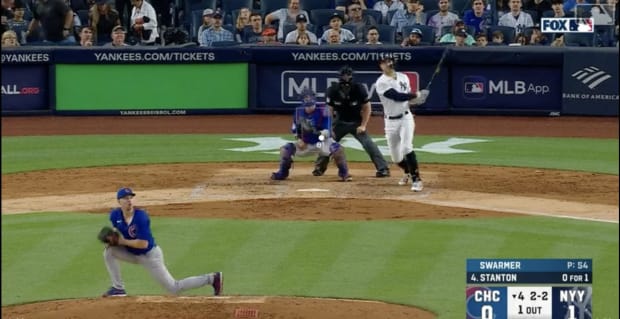
via MLB.com
An explanation feels almost superfluous here. You can learn that this was Matt Swarmer’s reaction to Giancarlo Stanton’s hitting a baseball 119.8 mph—the hardest-hit home run of the season—or you can simply look at his position here. The image communicates just as much as the statistic.
But there is actually something else worth knowing. This game offered us not only the hardest-hit home run of the year but also the most home runs allowed by one pitcher in a day: The Cubs rookie gave up six Yankees dingers on this fine Saturday. (All were solo shots; Swarmer allowed just one hit in five innings that was not a home run.) This Stanton shot was only the second of the day. It made a 1–0 deficit a 2–0 deficit; in and of itself, it was frustrating, of course, but not automatically damning. There was no reason to believe that a loss was inevitable or that a nightmare performance was incoming.
And yet, this was the only home run to elicit a reaction like this. When Swarmer allowed his fourth homer of the day (to Jose Trevino) or fifth (Aaron Judge) or sixth (Anthony Rizzo), his reaction was minimal, sometimes a gaze over the fence to watch it fly, sometimes not even that. Those later home runs theoretically should have seemed more damaging: The sixth homer of the night is worse than the second. But it was only this one, Stanton’s blast, 119.8 mph, with a crack of the bat that made itself painfully, abundantly clear, that saw Swarmer react like this. It was only this kind of power that made him twist to bear witness. If the pitcher’s reaction is typically separate from his delivery—two distinct movements divided by a beat of processing—here they were simply one. Swarmer delivered the pitch, and before he could straighten up, before he could finish his motion, he knew, he knew that he needed to turn and see what he had done.
The One That Flew the Farthest
Game: Diamondbacks at Rockies, Sept. 9
Batter: C.J. Cron
Pitcher: Keynan Middleton
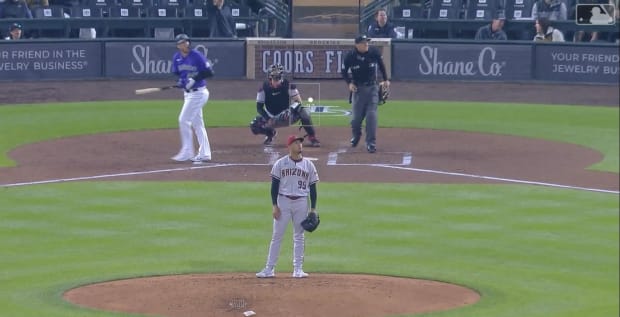
via MLB.com
This kind of game seems like it exists to be forgotten. (The above tagline includes “September,” “Diamondbacks” and “Rockies.” Not just one of those words: all three!) Yet so much of the joy of baseball lies in how those games are often the ones to feature the weirdest moments. Like, say, C.J. Cron’s hitting a ball a projected distance of 504 feet—the only home run this year to go farther than 500 feet. That is not immediately obvious here from the catcher or umpire or scattered fans or even from Cron. But it’s obvious from Keynan Middleton. Just look: Cron still has a foot in the box, yet Middleton has turned completely around, shoulders square to the outfield, arms hanging by his side, gaze upturned.
He is not so much a pitcher in this moment as a witness. The other people in this scene are captured in moments of processing—on the pathway to understanding. But Middleton knows what he sees. He can only watch it go.
The One That Flew the Farthest: Playoff Edition
Game: Phillies at Padres, Oct. 18
Batter: Kyle Schwarber
Pitcher: Yu Darvish
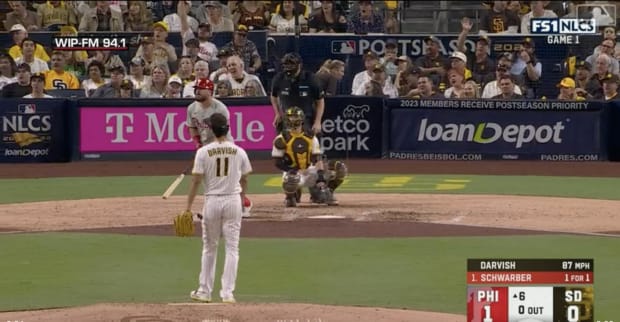
via MLB.com
Maybe it seems hard to believe that Phillies slugger Kyle Schwarber’s upper-deck blast in Game 1 of the NLCS was not the longest home run of the year. In the moment, certainly, it seemed not just the longest of the year but perhaps the longest ever hit. Everything about it seemed impossible. But at a projected 488 feet, somehow, it ended up merely in sixth place.
Which—the farthest hit, part of the top five, in the top 10, what’s the difference at that point? Padres righthander Yu Darvish knew what was going on here. He didn’t have to look at it. Why bother to turn around? The outcome was obvious. There was no point in watching the details. Ball, please: Next batter.
The One Off the Hardest Pitch
Game: Giants at Diamondbacks, July 5
Batter: Daulton Varsho
Pitcher: Camilo Doval
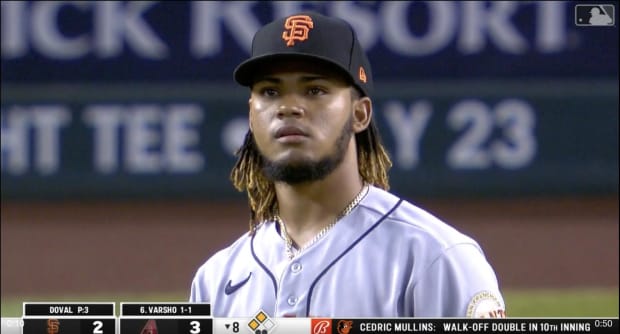
via MLB.com
The composition of this one looks a bit different. It is the only example here where the opposing broadcast immediately zoomed in on the pitcher’s face. But they had good reason. Giants righthander Camilo Doval throws hard. He has a cutter that sits at 99 mph and regularly goes even harder. He was one of just nine pitchers this year to throw more than 150 pitches at over 100 mph. That left, of course, a lot of pitches under 100 mph—he uses his slider more than his cutter—but of those triple-digit pitches, well, they usually worked out for him. Doval understands how hard it is to do anything with 101-mph heat. Hitters do, too.
Except for this July day in Arizona, when Doval threw 101.8 mph and somehow, someway, Daulton Varsho sent it over the wall. No one would turn a harder pitch into a home run this year. It was a triumph for Varsho. But it was a remaking of reality for Doval. And the broadcast knew just where to go.
The One With the Highest-Leverage Index
Game: Marlins at Phillies, June 15
Batter: Garrett Stubbs
Pitcher: Tanner Scott
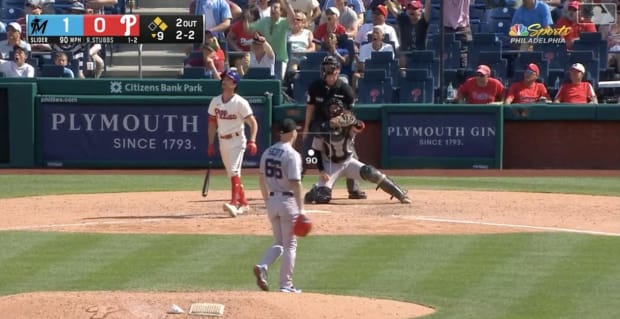
via MLB.com
1–0 ball game. Bottom of the ninth. Two on. Two out. Two strikes. The light-hitting backup catcher is at the plate.
Do you know what you do when you give up a home run there? What do you do when you realize you have become the faceless pitcher from the exposition of a childhood backyard fantasy? You do just what Marlins pitcher Tanner Scott did here. You start walking off the mound. It’s over, buddy. Phillies catcher Garrett Stubbs has achieved his walk-off dream here. You played the part no one wants to play. But no one says you have to stay and watch.
The One on the First Pitch
Game: Angels at Rangers, April 15
Batter: Shohei Ohtani
Pitcher: Matt Bush
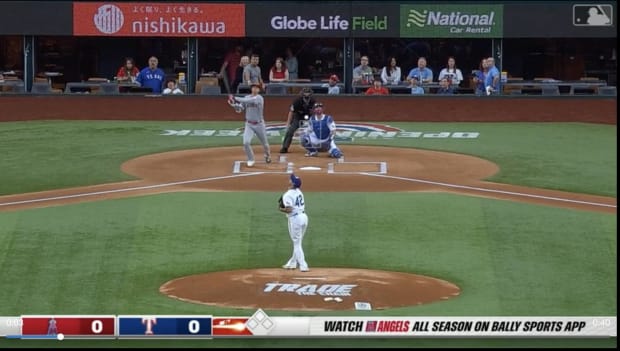
via MLB.com
There were 22 home runs this year that came on the first pitch of the game. (Not the first plate appearance—the first pitch.) But this was the first of those, as well as the first home run of the year for Angels superstar Shohei Ohtani, and it yielded a perfect reaction from Rangers pitcher Matt Bush. He did not look back at it. He simply looked up.
The One That Sealed the World Series
Game: Phillies at Astros, Nov. 5
Batter: Yordan Alvarez
Pitcher: José Alvarado
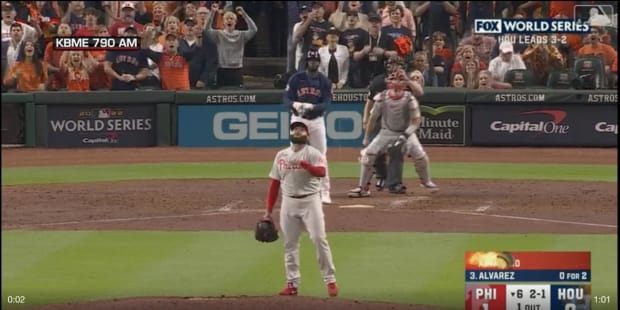
via MLB.com
The crowd makes this moment obvious: While Yordan Alvarez watches his star-hanging hit, processing what he has just done, Houston fans reveal the frenetic, joyfully deranged energy that registers World Series–winning home run. They capture precisely what is happening here.
And the pitcher, José Alvarado, captures whatever you want him to. What do you see? Perhaps it’s denial in the stance; anger in the mouth left hanging open; bargaining in the left hand, brought to his chest, grasping at nothing; depression in the eyes; acceptance in the glove, finally, turned downward. Perhaps it’s something else. He can be a mirror, or a void, or an answer. There is so much in this picture that is obvious. Alvarado is not.
The One That Made History
Game: Yankees at Rangers, Oct. 4
Batter: Aaron Judge
Pitcher: Jesús Tinoco
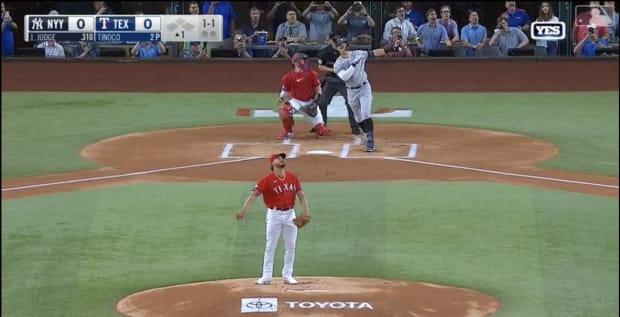
via MLB.com
On the one hand, yes, Jesús Tinoco made himself into the answer to a trivia question by giving up No. 62 to Aaron Judge. But on the other? There are dozens and dozens of versions of this highlight. There are some where the camera stays fixed on Judge as he makes his way around the bases. There are some where it follows the ball. There are some where it darts into the dugout, into the crowd, across the face of Roger Maris Jr., watching his father’s record fall at last after weeks of watching Judge across the American League. There are some that slice up pieces of all of the above. And you know what? There is not a single one that focuses on Tinoco. His full reaction does not show up in any of these. In the future, when people give his name at bar trivia and for stadium scoreboard contests, they will not know what he did after the dinger. We see Tinoco turn to track the ball’s arc into the stands—a witness to the history for which he just set the stage—and we do not see him again until he is settling in to finish the inning.
Whatever he did in the interim belongs only to him.







